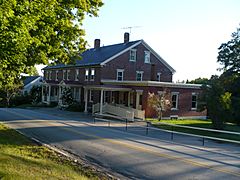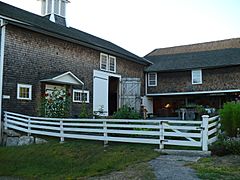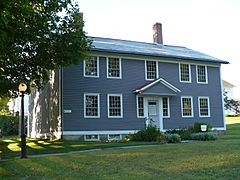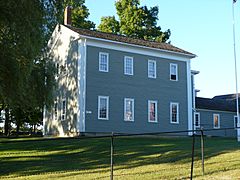Canterbury Shaker Village facts for kids
|
Canterbury Shaker Village
|
|

Shaker Village c. 1920
|
|
| Lua error in Module:Location_map at line 420: attempt to index field 'wikibase' (a nil value). | |
| Nearest city | 288 Shaker Road, Canterbury, New Hampshire |
|---|---|
| Built | 1792 |
| NRHP reference No. | 75000129 |
Quick facts for kids Significant dates |
|
| Added to NRHP | June 17, 1975 |
| Designated NHLD | April 19, 1993 |
|
Canterbury Shaker Village
Spiritual name: Holy Ground
|
|
|---|---|
|
Shaker community
|
|
| Bishopric | Canterbury |
| Established | 1792 |
| Declared a National Historic Landmark | 1993 |
| Population
(1840)
|
|
| • Maximum | 260 |
| Families | Church, Second, North, West |
Canterbury Shaker Village is a special historic place and museum in Canterbury, New Hampshire, United States. It was once home to a group of people called the Shakers. They built many communities in the 1800s.
This village is one of the best-preserved Shaker sites still around today. Because of its importance, it was named a National Historic Landmark in 1993.
A non-profit group started in 1969 now runs the village. Their goal is to keep the Shaker history alive. Canterbury Shaker Village is known worldwide. It has 27 original Shaker buildings and four rebuilt ones. The village also includes 694 square kilometers (268 square miles) of forests, fields, gardens, and ponds. These lands are protected forever. The village helps people learn about the Shakers' 200-year story. It is also a place for thinking and finding new inspiration.
Contents
Exploring Canterbury Shaker Village History
How the Shaker Community Started and Grew
The Canterbury Shaker Village was one of two main Shaker communities in New Hampshire. These two villages, Canterbury and Enfield, were part of a larger group called a "bishopric." A bishopric helped organize different Shaker villages in the same area. It made it easier for them to communicate and plan events together.
In 1782, two Shakers, Israel Chauncey and Ebeneezer Cooley, visited Canterbury. They convinced several important local families to join their faith. These families, including the Whitchers, Wiggins, and Sanborns, later gave land for the village. The Canterbury Village officially began in 1792. Father Job Bishop led the new community.
The village quickly grew. By 1803, there were 159 members living in three different Shaker families. About 50 years later, in 1850, the village covered 3,000 acres (12 square kilometers). It had about 300 members living in 100 buildings.
New Ideas and Inventions in the Village
Over the years, the Canterbury Shakers adopted many new inventions from the outside world. As Stephen Stein wrote in his book The Shaker Experience, new ways to travel, power machines, and communicate changed their lives. These changes showed how the Shakers were open to modern ideas.
For example, in 1901, the New England Telephone Company put telephones in the Canterbury Village. This meant Shakers no longer had to travel long distances to talk to other Shaker communities.
In 1910, the Canterbury Village built its own powerhouse. It cost $8,000. At first, the power generator lit up 16 community buildings with electricity. Later, in the 1950s, friends of the community even gave the Canterbury Shakers a television set.
The Shakers also created their own helpful inventions. The Canterbury Shakers invented and patented a washing machine. This invention was so good that it won a gold medal at the Centennial Exposition in 1876.
Music was a very important part of Shaker life at Canterbury. They wrote many spiritual songs, like "Celestial Praises" in 1841 and "We Will All Go Home with You" in 1862. Between 1842 and 1908, the Canterbury Shakers published eleven different songbooks.
Why the Community Became Smaller
The number of Shakers in Canterbury began to decrease over time. In 1905, there were 100 members. By 1916, only 49 Shakers remained: 47 women and two men. There were also 12 girls under 21 and one non-Shaker living in the village.
Brother Irving Greenwood, the last male member of the Canterbury Village, passed away in 1939.
In 1947, a reporter from LIFE magazine visited the village. She found 16 sisters still living there, aged 43 to 80.
In 1957, after much thought, the Shaker leaders decided to close the Shaker Covenant. This document was what new members had to sign to join the Shakers. Eldress Bertha Lindsay explained in 1988 that the official covenant was locked away. This meant no new members could join the Shakers.
By 1980, Canterbury Shaker Village had opened its doors to visitors as a historic site. People could take tours, meet some of the remaining Shakers, and visit a gift shop called "Simple Gifts." In 1992, 60,000 people from all over the world visited the village.
In 1988, Eldress Gertrude Soule died. This left only two Shakers at Canterbury Village: Eldress Bertha Lindsay and Sister Ethel Hudson. They were 93 and 96 years old. Eldress Bertha Lindsay, the last Shaker eldress, passed away on October 3, 1990. This left only Sister Ethel Hudson at Canterbury. She died in September 1992 at the age of 96.
How the Shakers Organized Their Community
The Shakers had a clear system for organizing their communities. It had four main levels:
- Family: This was the first level, and every member of the community belonged to a family.
- Elders and Eldresses: Above the families were leaders known as elders and eldresses. There were also deacons and deaconesses who helped manage daily tasks.
- Ministry: The third level was a ministry, usually made up of two men and two women. This group governed the individual Shaker communities.
- Bishopric: The highest level was the bishopric. This group oversaw several local Shaker communities, like Canterbury and Enfield.
Village Buildings
Important People from Canterbury Shaker Village
- Henry Clay Blinn, a Shaker Elder, artist, and writer.
- Thomas Corbett, a Shaker doctor.
- Cora Helena Sarle, an artist known for her watercolor paintings.
- Mary Whitcher, known as the "Shaker poetess" for her writings.
See also
- List of National Historic Landmarks in New Hampshire
- National Register of Historic Places listings in Merrimack County, New Hampshire
- New Hampshire Historical Marker No. 15: Shaker Village
- Pleasant Hill, Kentucky, another Shaker community
- Shaker Seed Company






